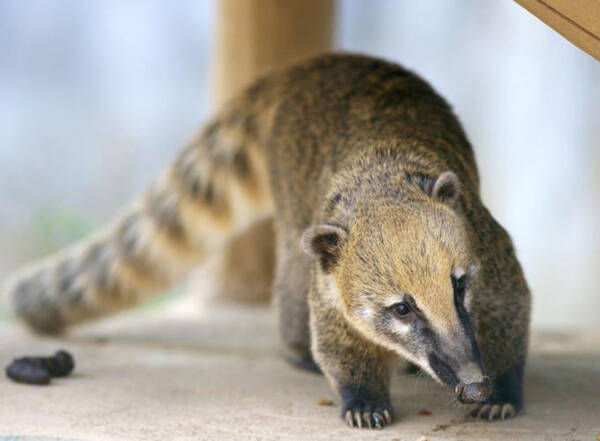Nasuella olivacea
IUCN
LCBasic Information
Scientific classification
- name:Nasuella olivacea
- Scientific Name:Nasuella olivacea,Mountain Coati、Western Mountain Coati,Yamaguchi
- Outline:Carnivora
- Family:Procyonidae Procyoninae Raccoon
Vital signs
- length:40-54cm
- Weight:1-1.5kg
- lifetime:About 12 years
Feature
The smallest raccoon, with coarse fur and dark olive and brown body coloration, with lighter brown throat and chest with a reddish hue.
Distribution and Habitat
Distributed in the Andes Mountains of western Venezuela, Colombia, Ecuador, and possibly Peru.
Coatis live in cloud forests and paramo scrub at altitudes of 1,300-4,250 meters. They are well adapted to artificial Andean alder forests.
Appearance
Body length is 40-54 cm; tail length is 19.2-30 cm; weight is 1-1.5 kg. Length from nose to tip of tail is 70-80 cm. It is the smallest raccoon, with rough fur and dark olive and brown body color, with lighter brown throat and chest, with a light red hue. The coatis distributed in Colombia and Venezuela have black undercoat, while the coatis from Ecuador have white undercoat. The face is narrow and long, gradually narrowing from head to nose, with a sharp nose tip and no hair. The tail has a black ring with gray or light gray, and is often held upright when walking.
Details
The coati (scientific name: Nasuella olivacea) is also known as Mountain Coati and Western Mountain Coati in foreign languages. It has three subspecies.

The coati's main food is soil invertebrate adults and larvae, especially beetles, grasshoppers, locusts, centipedes, millipedes, and ants. Frogs are the most common small vertebrate food (based on limited data). It also eats fruits, leaves, grass roots, and mosses. It is said to kill poultry and steal potatoes, but there is no conclusive evidence. Presumably forages in social groups during the day. Leaves behind large areas of disturbed soil and many distinctive holes dug with claws and probing with noses. More than 5,000 of these holes were found in a 35 square meter moss bank.
Small groups and single individuals were observed, suggesting social patterns similar to other raccoons. Groups are usually 6-8, but larger groups of 50-80 have been observed. The only data on nesting area is 0.11 square kilometers (from a male monitored for 3 months in Colombia).
The breeding season for coatis is from February to March each year, when a male will mate with several females. Gestation is 74-77 days, with 3-6 pups per litter. The cubs are weaned at 4-5 months old, but they remain close to their mothers until they give birth to their next cub in the second year. Both males and females reach sexual maturity within 2-3 years. When young males reach sexual maturity between 2-3 years old, they are driven away from the group. Females reach sexual maturity in about 2 years, but they will still stay in the group.
Listed in the "Red List of Endangered Species of the World Conservation Union" (IUCN 2015 ver 3.1) - Near Threatened (NT).
Protect wild animals and eliminate game.
Maintaining ecological balance is everyone's responsibility!








